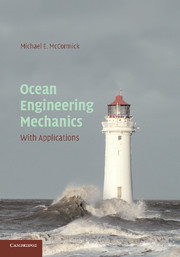Book contents
- Frontmatter
- Contents
- Preface
- Notation
- OCEAN ENGINEERING MECHANICS
- 1 Introduction
- 2 Review of Hydromechanics
- 3 Linear Surface Waves
- 4 Nonlinear Surface Waves
- 5 Random Seas
- 6 Wave Modification and Transformation
- 7 Waves in the Coastal Zone
- 8 Coastal Engineering Considerations
- 9 Wave-Induced Forces and Moments on Fixed Bodies
- 10 Introduction to Wave-Structure Interaction
- 11 Wave-Induced Motions of Floating Bodies
- 12 Wave-Induced Motions of Compliant Structures
- Appendices
- References
- Index
9 - Wave-Induced Forces and Moments on Fixed Bodies
Published online by Cambridge University Press: 05 June 2012
- Frontmatter
- Contents
- Preface
- Notation
- OCEAN ENGINEERING MECHANICS
- 1 Introduction
- 2 Review of Hydromechanics
- 3 Linear Surface Waves
- 4 Nonlinear Surface Waves
- 5 Random Seas
- 6 Wave Modification and Transformation
- 7 Waves in the Coastal Zone
- 8 Coastal Engineering Considerations
- 9 Wave-Induced Forces and Moments on Fixed Bodies
- 10 Introduction to Wave-Structure Interaction
- 11 Wave-Induced Motions of Floating Bodies
- 12 Wave-Induced Motions of Compliant Structures
- Appendices
- References
- Index
Summary
The majority of engineering problems encountered by ocean engineers involve wave-structure interactions. The waves in these interactions are altered and modified because of both the presence and motions of fixed and floating structures. The analyses of the wave-induced forces and motions of fixed structures require somewhat different mathematical tools than the analyses of wave-structure interactions of floating bodies. Wave-induced forces and motions of floating bodies are introduced in Chapter 10 and discussed in depth in Chapter 11.
The mathematical foundations on which contemporary analyses of wave-structure interactions are based date back to the nineteenth century when Stokes (1851) demonstrated that the total force on a body in an unsteady flow consisted of two components, those being a drag force and an inertial reaction of the fluid. The objects of the Stokes study were pendula (hanging circular cylinders and one with a spherical weight) moving in a viscous fluid where free-surface effects were not considered. Our interest begins with works done in the early part of the twentieth century, when most of the wave-structure interactions involved submerged horizontal circular cylinders. The orientations of the cylinders of interest were horizontal and fully submerged with their axes parallel to the wave fronts, as discussed by Havelock (1917), Lamb (1932), and others. In the Havelock and Lamb references, it is demonstrated how integral transforms and integral equations can be used to represent the free-surface response to a fully submerged, horizontal cylinder.
- Type
- Chapter
- Information
- Ocean Engineering MechanicsWith Applications, pp. 273 - 349Publisher: Cambridge University PressPrint publication year: 2009



